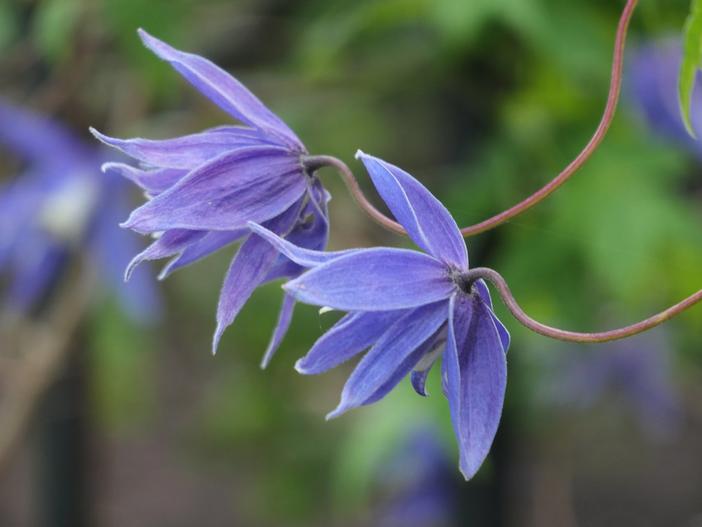Downy Clematis
(Clematis macropetala)
Downy Clematis (Clematis macropetala)
/
/

Amanda Slater
CC BY-SA 2.0
Image By:
Amanda Slater
Recorded By:
Copyright:
CC BY-SA 2.0
Copyright Notice:
Photo by: Amanda Slater | License Type: CC BY-SA 2.0 | License URL: https://creativecommons.org/licenses/by-sa/2.0/ | Uploader: amandabhslater | Publisher: Flickr



























Estimated Native Range
Summary
Clematis macropetala, commonly known as Downy Clematis, is a deciduous perennial vine originating from the temperate regions of Eastern Asia and Siberia, particularly in forest margins and stream banks. It typically grows to a height of 8-12 feet (2.4-3.7 meters) and a width of 3-6 feet (0.9-1.8 meters), with a climbing habit that makes it suitable for trellises and arbors. The plant is adorned with nodding, bell-shaped flowers in various shades including blue, cream, pink, purple, and white, which bloom profusely in the spring and are quite showy. The foliage is compound with a feathery appearance, adding to its ornamental value.
Downy Clematis is valued for its early spring flowers and its ability to climb, providing vertical interest in gardens. It is often used for covering walls, fences, and pergolas. This plant is relatively easy to maintain, requiring only occasional pruning to promote vigorous growth and flowering. It prefers a position with full sun to part shade and thrives in well-drained soils. While it needs regular watering, it is important to avoid waterlogged conditions. The cultivars ’Ballet Skirt’, ’Lagoon’, ’Pauline’, and ’Wesselton’ have been recognized with the Royal Horticultural Society’s Award of Garden Merit, indicating their exceptional qualities in garden settings. Potential issues include clematis wilt and pests such as aphids and slugs. It is also worth noting that the plant can become top-heavy and may require support as it grows.CC BY-SA 4.0
Downy Clematis is valued for its early spring flowers and its ability to climb, providing vertical interest in gardens. It is often used for covering walls, fences, and pergolas. This plant is relatively easy to maintain, requiring only occasional pruning to promote vigorous growth and flowering. It prefers a position with full sun to part shade and thrives in well-drained soils. While it needs regular watering, it is important to avoid waterlogged conditions. The cultivars ’Ballet Skirt’, ’Lagoon’, ’Pauline’, and ’Wesselton’ have been recognized with the Royal Horticultural Society’s Award of Garden Merit, indicating their exceptional qualities in garden settings. Potential issues include clematis wilt and pests such as aphids and slugs. It is also worth noting that the plant can become top-heavy and may require support as it grows.CC BY-SA 4.0
Plant Description
- Plant Type: Vine
- Height: 8-12 feet
- Width: 3-6 feet
- Growth Rate: Moderate
- Flower Color: Blue, Pink, Purple
- Flowering Season: Spring
- Leaf Retention: Deciduous
Growth Requirements
- Sun: Full Sun, Part Shade
- Water: Medium
- Drainage: Medium
Common Uses
Bee Garden, Bird Garden, Butterfly Garden, Deer Resistant, Fragrant, Hummingbird Garden, Low Maintenance, Potted Plant, Rabbit Resistant, Showy Flowers, Street Planting
Natural Habitat
Temperate regions of Eastern Asia and Siberia, particularly in forest margins and stream banks
Other Names
Common Names:
Scientific Names: , Clematis macropetala, Atragene macropetala, Clematis macropetala f. rupestris, Atragene macropetala var. punicoflora, Atragene macropetala var. rupestris, Clematis alpina subsp. macropetala, Clematis alpina var. macropetala, Clematis alpina var. rupestris, Clematis macropetala subsp. punicoflora
GBIF Accepted Name: Clematis macropetala Ledeb.